As I just hit “publish” on my catalogue of Ascenders variations, I thought it may be useful to have a look at the flourishing habits of past writing masters and take the time to explain the few rules of flourishing…
I think it is quite clear that calligraphers today are very attracted to flourishing… I remember that right after going through my first Skillshare class on calligraphy1 That was back in 2014, with Molly Jacques ! It was awesome ! You can get 3 months for free by clicking this link by the way !, I wasn’t yet able to make a good looking oval but I was eager to make ugly figure eight everywhere on my practice pages ! Of course, I quickly learned that even if it is easy to add plenty of curlicues to a word, flourishing does not always make a word more beautiful… Even now that my script looks better than it did a few years ago, I still struggle with finding balance between ornamentation and legibility.
The truth is that even in the “golden age of the writing master”, the 17th and 18th century, scribes did not agree on the issue, and “command of hand” was at the root of many heated disagreements between masters. The English Round Hand itself was developed in an attempt to make writing more efficient, after masters such as Edward Cocker or John Seddon2Edward Cocker was active from 1657 to 1700 and Seddon’s best works were published right around the time he died, in 1700. had meant to elevate the plain italian hand to the level of work of art. For penmen of their generation, the mastery of decorative and textual line was a testimony of a master’s skill : ultimately, these men wanted to attract real-life pupils more than they meant to help people learn without a master. However, the practice of such elaborate “striking” led to nearly illegible text.
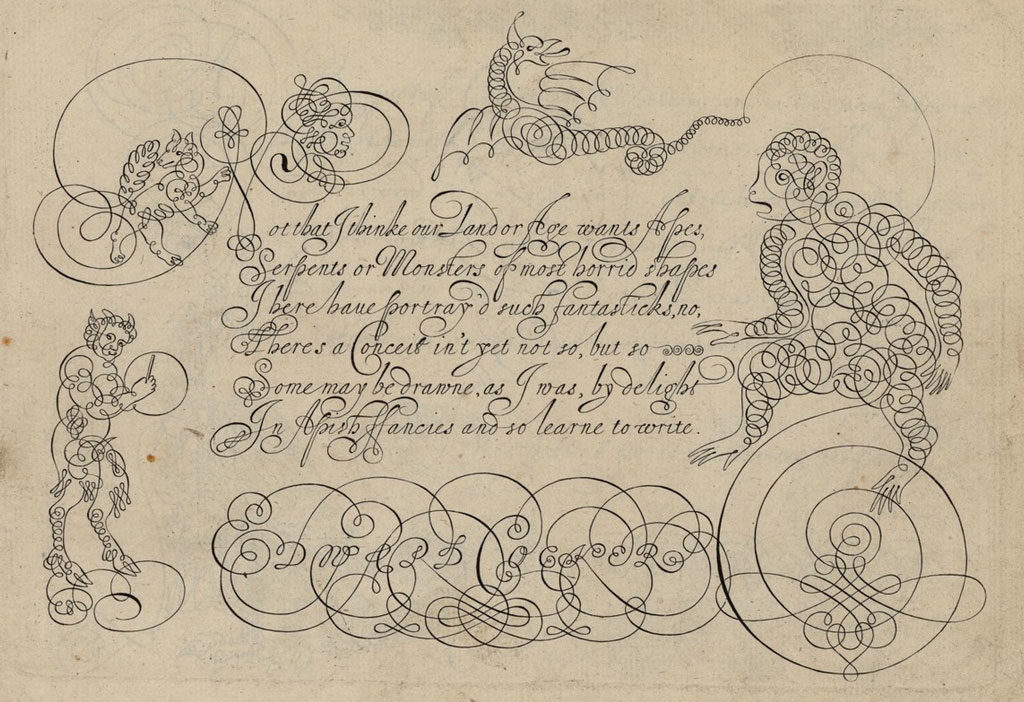
In the early years of the Round Hand, even when all masters agreed that an efficient and well written hand was important to help promote British trade, it took some time for all of them to agree on the amount of ornamentation allowed in copybooks. A famous feud opposing Charles Snell with John Clark and George Shelley, started out as a disagreement about the use of flourishing : Snell accused Shelley of making “owls, apes and sprig’d letters so great a part of (his) copybooks” in hopes of “amusing the ignorant and gain the reputation of master”3Charles SNELL, Art of Writing in its theory and practice, 1712. He was referring to the last page of George Shelley’s NAtural Writing in all the hands, on which the border was decorated with opulent flourishes, like banches on which lived drawn creatures : squirrel, owl, dragon, monkey, snails and birds…. John Clark later defended Shelley in the preface of his own book : “(Flourishing) Is not of use to men of business, or any qualification of a master (…). Writing is the most substantial part, the improvement of which all penmen should propose to themselves chiefly to study. (…) But yet, the practice of striking, and sprigging of letters are pretty ingenious exercises for youths at their leisure hours, and may also serve to please such who admire the fancy of the pen, as well as the solid uses of it”4John CLARK, Writing Improv’d, 1714. The dispute escalated between Snell and Clark, even though the disagreement on the practice of “Sprigging of letters and pencilling of flourishes” quickly died down.
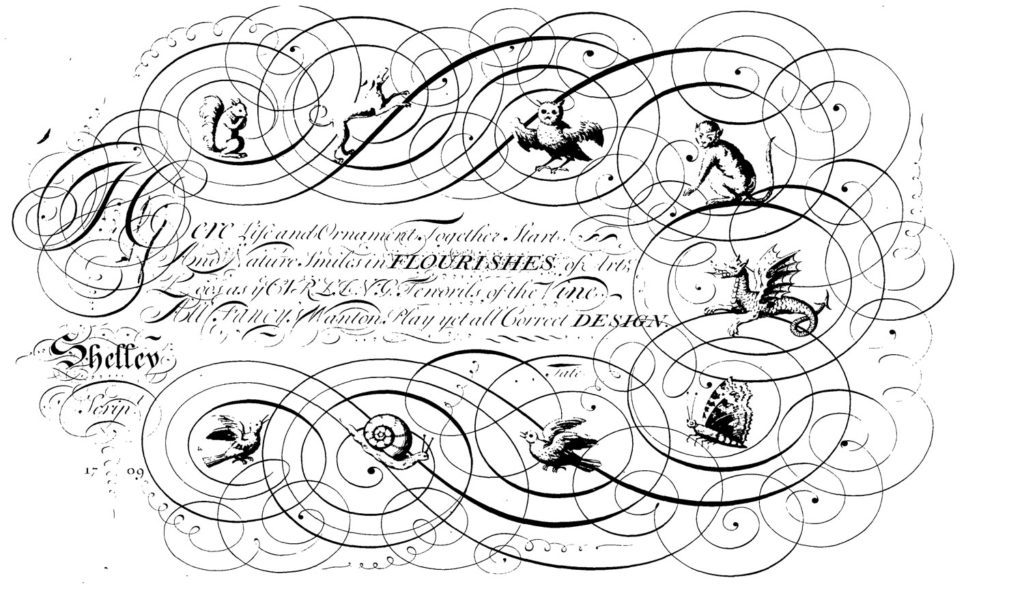
Snell’s rejection of all ornamentation was a bit drastic, but all Masters finally agreed that too much flourishing was not practical. At best, the practice of “command of hand” was seen as a nice way to improve one’s ability to produce beautiful lines. Even though the practice was never entirely banished, the place alloted to pictorial flourishes in copybooks was quickly reduced.
By 1714, when Shelley published the Second part of Natural Writing, he had drastically reduced his use of flourishes (both on and off-hand), which was probably more to the taste of the merchants and clerks, who actually used the Round Hand in their daily tasks. From this point on, most of the publications about the Round Hand were decorated with “well-behaved” ornamentation and contained much less controversial off-hand creatures. It seems natural that as the British hand was becoming more popular for “common affairs of trade and ordinary business of life”5John CLARK, Writing Improv’d, 1714, penmen naturally adapted their use of flourishing, confining them to the borders of the page, away from the body of text.
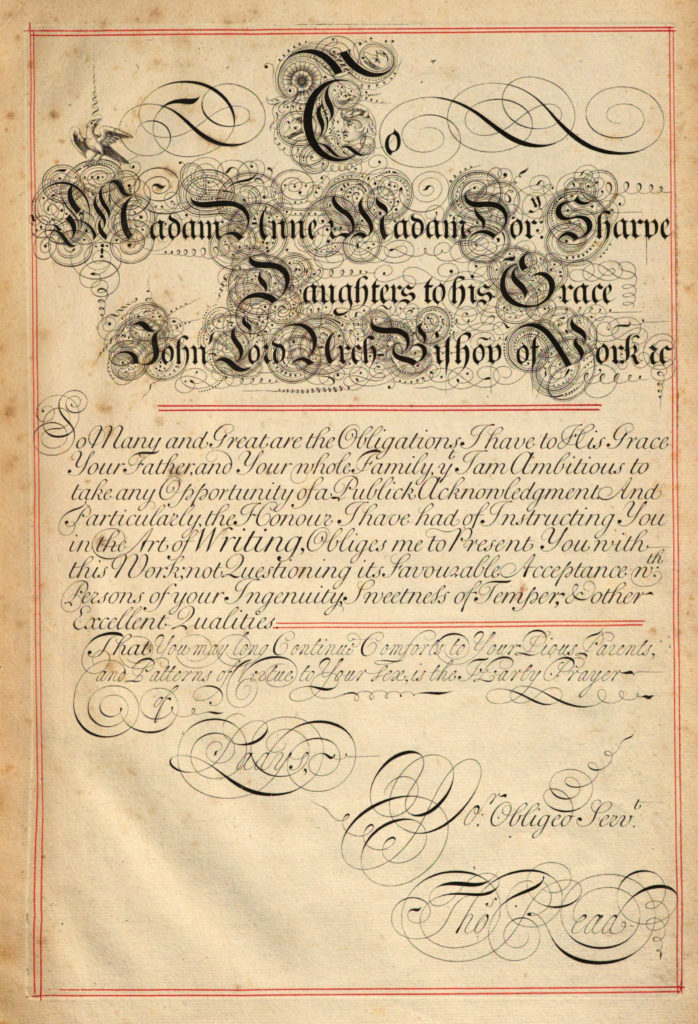
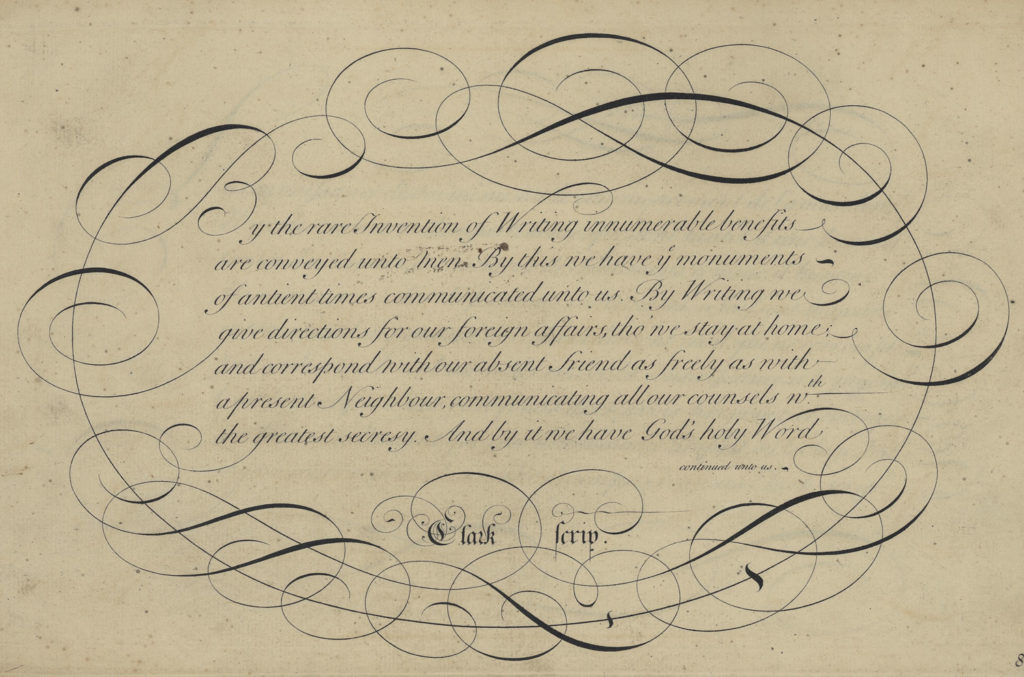
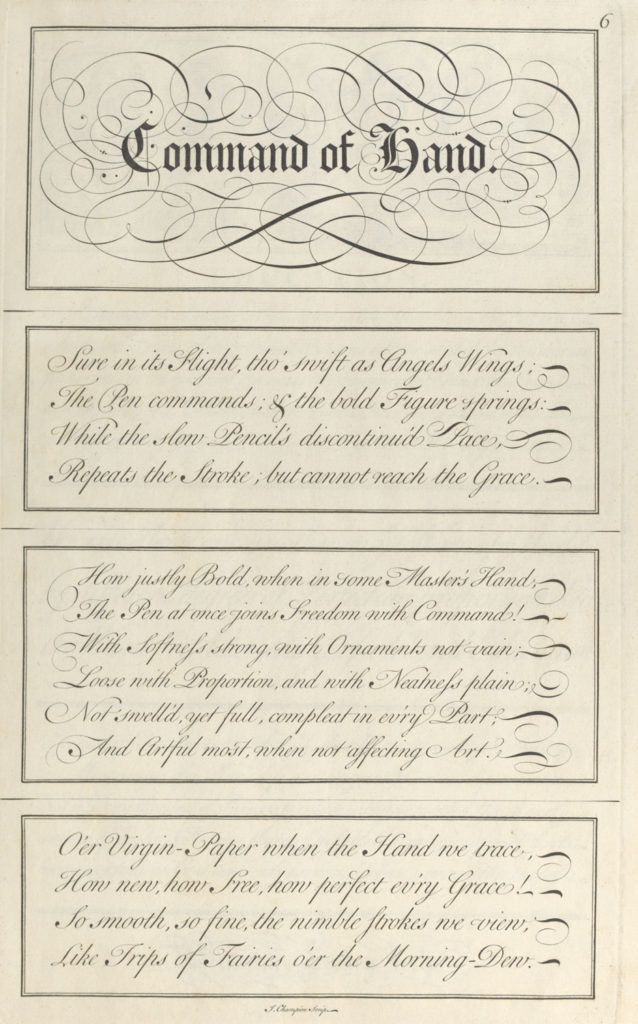
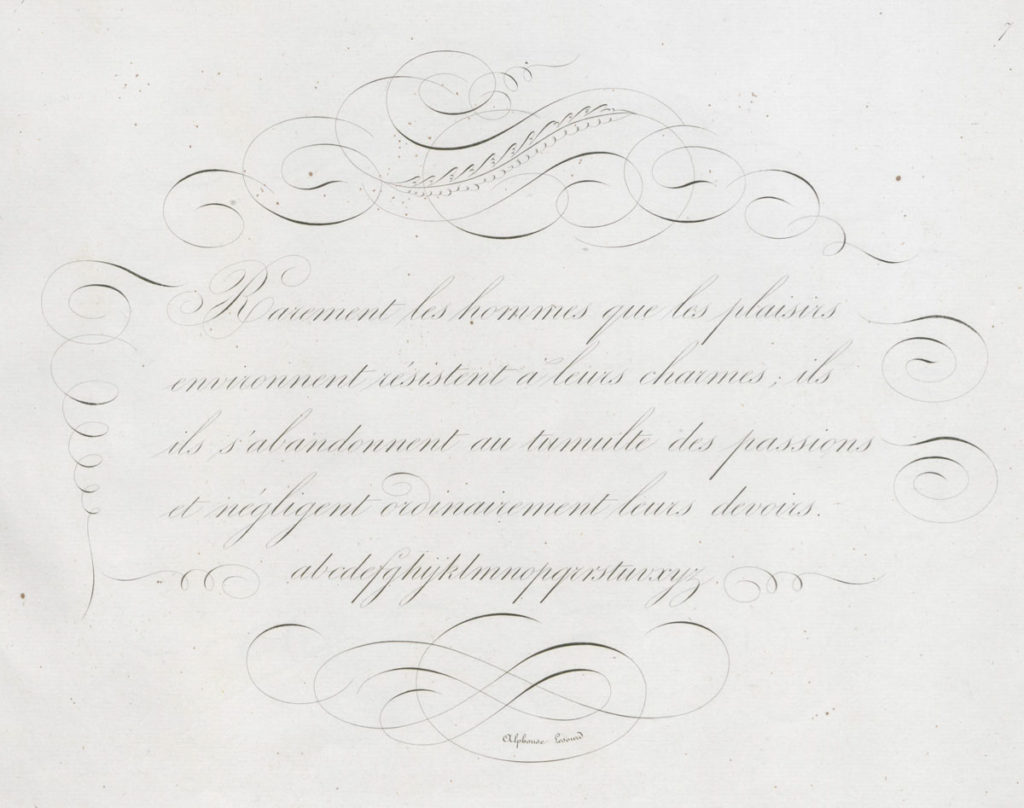
This being said, it is clear that for us, 18th century publications such as the Universal Penman are wonderful sources of inspiration when it comes to learning the elusive art of flourishing, even though they don’t offer much information on the subject.
The rules of Flourishing
We have all heard about the few rules of flourishing from contemporary masters, but I always felt like these rules were not complete, so I was thrilled to find out more in John Clark’s introduction in Writing Improv’d. Let me summarize his thoughts on the matter :
Clark insists that beginners should “take the time to write everything well, have regard for the true shape of every letter, and that they carefully avoid all unnecessary strokes, as well as long stems in their letters”. But contrary to what some people think (he is of course aiming at Snell), “ornament is allowable in this as well as in any other art or science. And as it is not to be attained without a laborious practice, so it is not to be disposed of without judicious consideration.”
However, he admits that it is hard to teach how to flourish, as this talent “proceeds from a peculiar genius and is the effect of a good fancy and a sound judgement”. But he gives these hints which we would now call “rules”.
– Be often observing of what has been done by the best masters. For this, let me direct you to the Bibliography section, or even better : my catalogues of variations.
– Get an exact idea of what you want to execute, if your head knows where to go, it will better lead your arm. Study flourishes just like you study letterforms : memorize one at a time, starting with simple ones, and let them grow into longer sequences of strokes.
– Let not your ornament obscure your writing, but let it be easy and natural.
– Aim for balance in your layout, it shouldn’t be full of strokes in some parts and in others empty and bald.
– Let the strokes turn and play with one another with as much wantonness and variety as you can, not running too much upon the spiral or parallel.
– Let not two dark strokes cross, but let them answer to one another, and lie all the same way like the shades in a picture. The eye must be able to notice that there is a “hierarchy” in your strokes to see order instead of chaos, vary the thickness of your shades, but do not allow the thick strokes in a flourish to diminish the legibility of a letter.
– Let not two strokes cross one another in the same point.
– Endeavour to make a few strokes well placed, rather than a crowd without any order or beauty. Be careful not to break the balance of your layout, flourish because it makes the design whole, not just because you like curlicues.
To these very useful hints, I would like to add this :
– Make your curves as graceful as you can : remember that the underlying shape of these flourishes is the oval. Edward Cocker’s “tip” for italian hand is also true for the Round Hand : “On Oval Wheels should fair Italian run, Smooth as the Whirling Chariot of the Sun”.
– Cross your strokes at angles as close to 90° as possible : if lines cross at acute angles, the eye has trouble identifying the path followed by the pen and the flourish becomes confusing.
– When crossing a stroke or shape, try and “cut” shapes of equal size : if you cut an oval, cut it in its center so the white space within the flourish appears as balanced as the flourish itself.
As for the technique itself, flourishing can be done in two different ways :
– Off-hand (which he calls figures of birds, beasts and such, knots and German Text capitals). For this, the most proper way of holding the pen is the “French hold”, with the “hollow side of the pen turned towards the end of your middle finger”
– On-hand which he calls Striking or Command of hand (the flourishing of letters by a quick motion). The pen-hold for on-hand flourishing on the Round Hand is the same as in writing. It is called the “Dutch manner”.
For either of these ways, “being made use of in their proper place, and perform’d with boldness and neatness, by a judicious master, will appear very beautiful and give a pleasant air to a piece of writing”. But in all cases,
– The center of movement for flourishing should be at the shoulder : the hand and arm must swing together in a free but controlled motion, the hand shouldn’t touch the paper with anything but the pen.
– The pen must not be turned in the hand while you are making a stroke.
– The slower the motion, the surer, but yet there must be such a boldness and freedom observed, that the stroke may be smart and clean, without roughness, or any flats and corners.
– Let your hand move with an easy motion and without hurry, performing as much with the continued motion of the pen as you possibly can, without straining or carrying it beyond what you can Command with freedom and ease.
– Sit upright, and lean very lightly upon your pen and right (or left) arm.
As you can see, the secret of flourishing is the same as the secret for calligraphy itself : careful study and constant practice. But it takes much more time and effort to be proficient at “Command of Hand” than at writing letters because the shapes are not as restrictive as letterforms, they just have to be beautiful and free…
Tell me, do you struggle with flourishing and composition too ? What are your tips and tricks to overcome your flourishing challenges ?


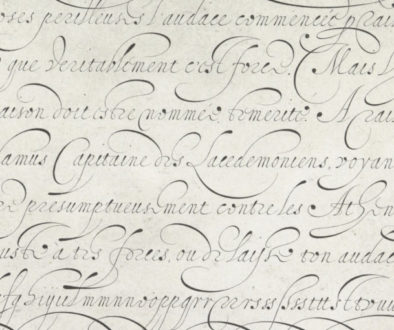
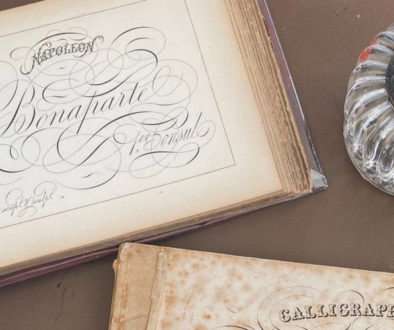
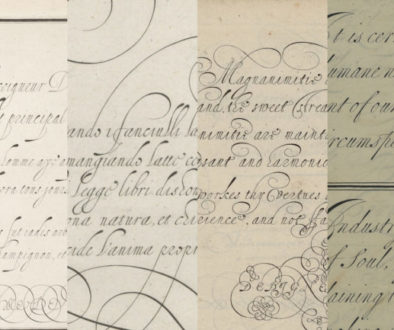
I have admired your work for years! This site is such a valuable resource to all of us who adore flourishing and calligraphy! Thank you!!
Hi Trisha ! Thank you so much for your kind comment! I’m happy this work is useful 😉
Oh what a great donation to the Arts this lovely site is. So much work, so much knowledge and even more enthusiasm. Penna Volans is the GO TO site for any calligrapher, experienced or novice. many , many thanks
Hello Henry. Thank you so much for your kind words, they mean a lot !
There is still so much that I want to share in these pages, the site will slowly grow, one post at a time 😉
Fabulous article and extremely practical rules for flourishing!!
Thank very much for sharing your knowledge about flourishing and Roundhand and Italian hand. Your web page is truly wonderful!!!
Thanks for your lovely comment, you made my day 😉